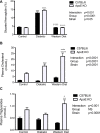Disparate Effects of Diabetes and Hyperlipidemia on Experimental Kidney Disease
- PMID: 32581831
- PMCID: PMC7283908
- DOI: 10.3389/fphys.2020.00518
Disparate Effects of Diabetes and Hyperlipidemia on Experimental Kidney Disease
Abstract
It is well established that diabetes is the major cause of chronic kidney disease worldwide. Both hyperglycemia, and more recently, advanced glycation endproducts, have been shown to play critical roles in the development of kidney disease. Moreover, the renin-angiotensin system along with growth factors and cytokines have also been shown to contribute to the onset and progression of diabetic kidney disease; however, the role of lipids in this context is poorly characterized. The current study aimed to compare the effect of 20 weeks of streptozotocin-induced diabetes or western diet feeding on kidney disease in two different mouse strains, C57BL/6 mice and hyperlipidemic apolipoprotein (apo) E knockout (KO) mice. Mice were fed a chow diet (control), a western diet (21% fat, 0.15% cholesterol) or were induced with streptozotocin-diabetes (55 mg/kg/day for 5 days) then fed a chow diet and followed for 20 weeks. The induction of diabetes was associated with a 3-fold elevation in glycated hemoglobin and an increase in kidney to body weight ratio regardless of strain (p < 0.0001). ApoE deficiency significantly increased plasma cholesterol and triglyceride levels and feeding of a western diet exacerbated these effects. Despite this, urinary albumin excretion (UAE) was elevated in diabetic mice to a similar extent in both strains (p < 0.0001) but no effect was seen with a western diet in either strain. Diabetes was also associated with extracellular matrix accumulation in both strains, and western diet feeding to a lesser extent in apoE KO mice. Consistent with this, an increase in renal mRNA expression of the fibrotic marker, fibronectin, was observed in diabetic C57BL/6 mice (p < 0.0001). In summary, these studies demonstrate disparate effects of diabetes and hyperlipidemia on kidney injury, with features of the diabetic milieu other than lipids suggested to play a more prominent role in driving renal pathology.
Keywords: albuminuria; cholesterol; diabetes; lipids; renal disease.
Copyright © 2020 Watson, Gould, Moody, Sivakumaran, Sourris, Chow, Koïtka-Weber, Allen, Jandeleit-Dahm, Cooper and Calkin.
Figures




Similar articles
-
Accelerated nephropathy in diabetic apolipoprotein e-knockout mouse: role of advanced glycation end products.J Am Soc Nephrol. 2004 Aug;15(8):2125-38. doi: 10.1097/01.ASN.0000133025.23732.46. J Am Soc Nephrol. 2004. PMID: 15284298
-
Hyperglycemia and hyperlipidemia act synergistically to induce renal disease in LDL receptor-deficient BALB mice.Am J Nephrol. 2004 Jan-Feb;24(1):20-31. doi: 10.1159/000075362. Epub 2003 Dec 10. Am J Nephrol. 2004. PMID: 14671436
-
Severe hypertriglyceridemia and hypercholesterolemia accelerating renal injury: a novel model of type 1 diabetic hamsters induced by short-term high-fat / high-cholesterol diet and low-dose streptozotocin.BMC Nephrol. 2015 Apr 11;16:51. doi: 10.1186/s12882-015-0041-5. BMC Nephrol. 2015. PMID: 25884847 Free PMC article.
-
The pleiotropic actions of rosuvastatin confer renal benefits in the diabetic Apo-E knockout mouse.Am J Physiol Renal Physiol. 2010 Sep;299(3):F528-35. doi: 10.1152/ajprenal.00127.2010. Epub 2010 Jun 16. Am J Physiol Renal Physiol. 2010. PMID: 20554645
-
Dietary polyunsaturated fatty acids slow the progression of diabetic nephropathy in streptozotocin-induced diabetic rats.Nutr Res. 2010 Mar;30(3):217-25. doi: 10.1016/j.nutres.2010.03.002. Nutr Res. 2010. PMID: 20417883
Cited by
-
Risk Factors and Comorbidities Associated with Diabetic Kidney Disease.J Prim Care Community Health. 2021 Jan-Dec;12:21501327211048556. doi: 10.1177/21501327211048556. J Prim Care Community Health. 2021. PMID: 34634970 Free PMC article.
-
Aerobic exercise training combined or not with okra consumption as a strategy to prevent kidney changes caused by metabolic syndrome in Zucker rats.PLoS One. 2022 Jun 3;17(6):e0269418. doi: 10.1371/journal.pone.0269418. eCollection 2022. PLoS One. 2022. PMID: 35657982 Free PMC article.
-
Association between non-high-density lipoprotein cholesterol to high-density lipoprotein cholesterol ratio and cardiovascular disease mortality in patients with type 2 diabetes mellitus and diabetic kidney disease.Front Endocrinol (Lausanne). 2025 Feb 28;16:1509752. doi: 10.3389/fendo.2025.1509752. eCollection 2025. Front Endocrinol (Lausanne). 2025. PMID: 40093754 Free PMC article.
-
The Relationship between Renin-Angiotensin-Aldosterone System (RAAS) Activity, Osteoporosis and Estrogen Deficiency in Type 2 Diabetes.Int J Mol Sci. 2023 Jul 26;24(15):11963. doi: 10.3390/ijms241511963. Int J Mol Sci. 2023. PMID: 37569338 Free PMC article. Review.
References
LinkOut - more resources
Full Text Sources
Research Materials
Miscellaneous

